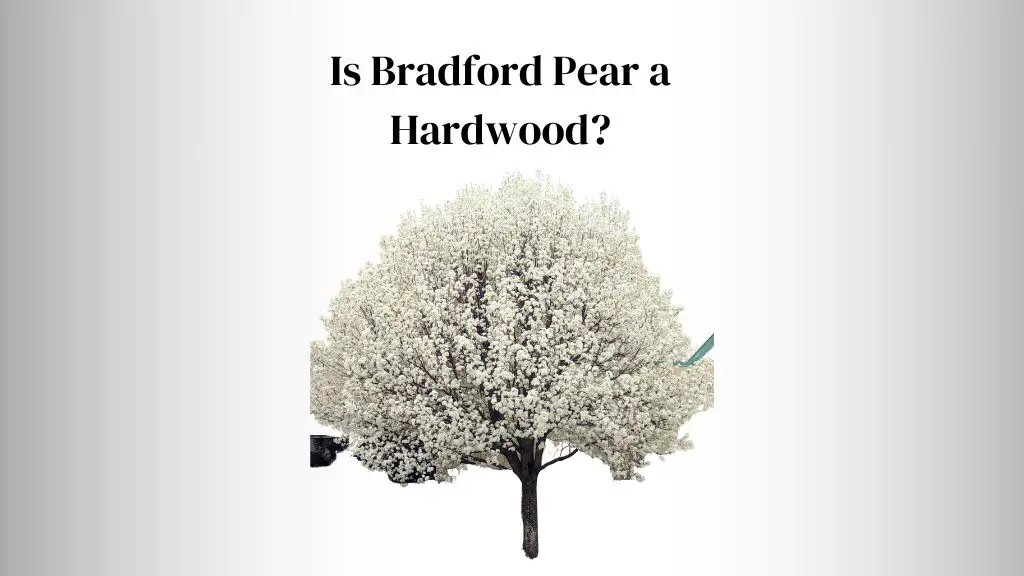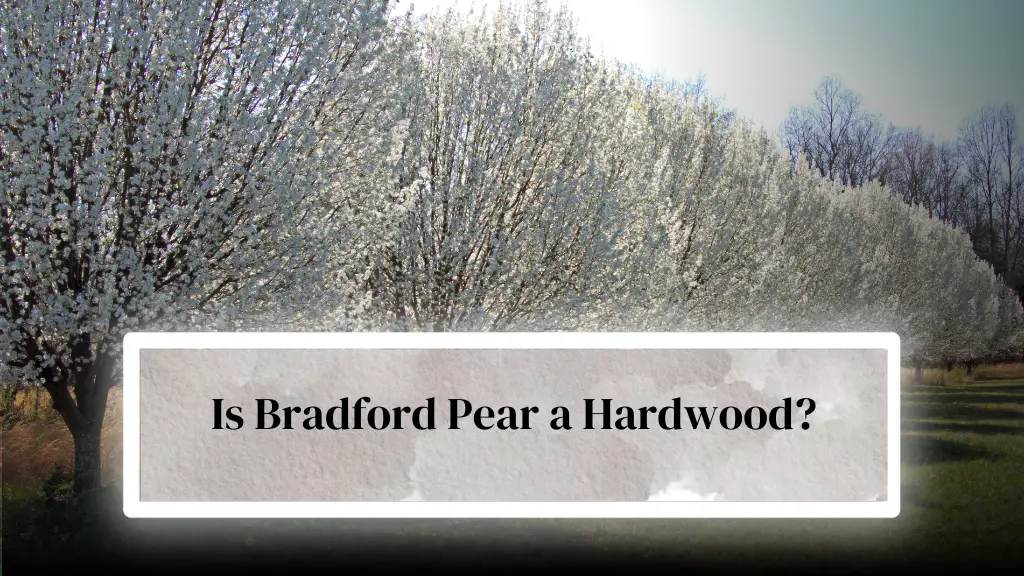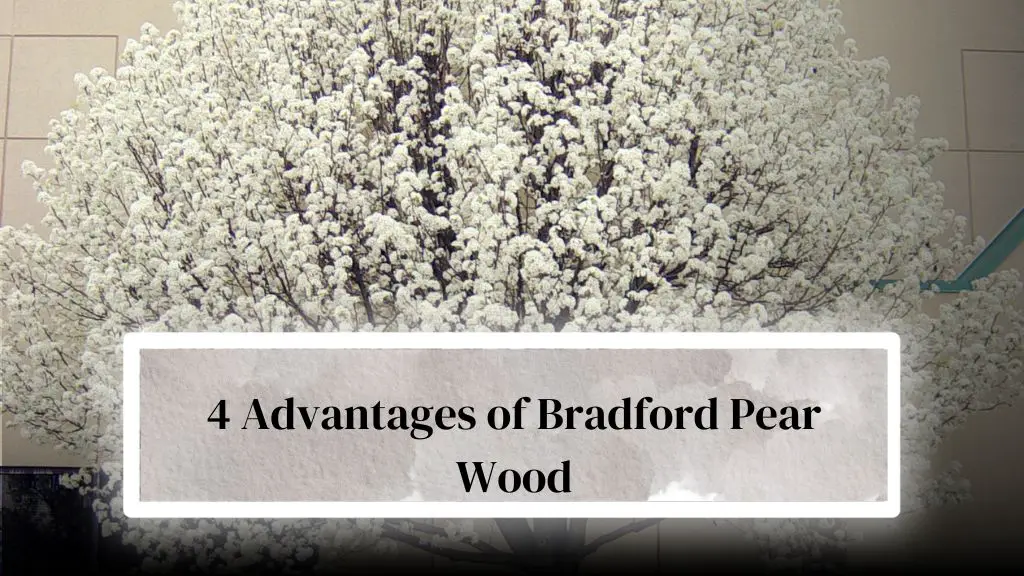
If you’re wondering, ‘Is Bradford Pear a Hardwood?’ you’re not alone. Every woodworker once comes across a Bradford Pear tree and wonders whether Bradford Pear is a Hardwood tree.
Since I’ve always been interested in the characteristics of various types of wood, I recently learned some intriguing facts regarding the physical _ and chemical characteristics of Bradford Pear wood while researching it.
I thought of writing down an article highlighting my research to you in this piece. Since Bradford Pear trees are fast-growing and can grow up to 50 feet tall, let’s talk Is Bradford Pear a Hardwood?
Is Bradford Pear a Hardwood?

Is Bradford Pear considered a hardwood? After researching the topic, I discovered that Bradford Pear is classified as a hardwood. Hardwoods are trees that produce broad leaves and are usually deciduous. They are generally harder and denser than softwoods.
The hardness of Bradford Pear Wood
Now let’s take a closer look at the hardness of Bradford Pear wood. Hardness is a measure of a wood’s resistance to indentation. It is an important property to consider when choosing a wood for a particular application. Hardness is usually measured using the Janka hardness test.
This test involves measuring the force required to embed a steel ball with a diameter of 11.28 millimeters into the wood to half its diameter. The Janka hardness scale is a standardized measure of wood hardness. It ranges from 0 to 4000, with higher numbers indicating harder woods.
Bradford Pear wood has a Janka hardness rating of around 1500 lbs, which puts it on par with other hardwoods such as cherry wood and maple wood.
In addition to the Janka hardness test, other tests can be used to measure the hardness of the wood, such as the Brinell hardness test and the Vickers hardness test. However, these tests are less commonly used than the Janka hardness test.
Physical Properties of Bradford Pear Wood
Color
Bradford Pear wood is generally light tan to pale yellow with a hint of pink. The heartwood tends to be slightly darker than the sapwood.
Grain pattern
The grain pattern of Bradford Pear wood is usually straight with a fine to medium texture. It has a uniform, closed grain that is easy to work with.
Density
Bradford Pear wood has a density of around 0.55 g/cm3. This makes it a medium-density hardwood.
Strength and durability
While Bradford Pear wood is less strong and durable than some other hardwoods, it is still a fairly strong and durable wood. It has a Janka hardness rating of around 1500 lbs, which puts it on par with cherry wood.
Other physical properties
Bradford Pear wood is easy to work with and finishes well. It is also fairly stable and has good bending properties.
Chemical Properties of Bradford Pear Wood
| Property | Value |
|---|---|
| Resistance to decay and insects | Moderately resistant |
| Toxicity | Not considered toxic but may cause skin irritation |
| Flammability | Low |
Chemical composition
Bradford Pear wood contains various chemical compounds, including cellulose, hemicellulose, and lignin. These compounds give the wood its physical properties. Bradford Pear wood has low flammability and is fairly stable when exposed to changes in temperature and humidity.
Resistance to decay and insects
Bradford Pear wood is moderately resistant to decay and insect infestation. However, it is less resistant than other hardwoods, such as oak or cedar.
Toxicity
Is Bradford Pear Wood toxic? After researching the topic, I discovered that Bradford Pear wood is not considered toxic. However, it may cause skin irritation in some people.
Comparison of Bradford Pear Wood Hardness to Other Woods
When it comes to hardness, Bradford pear wood is not as hard as some of the popular hardwoods like oak, maple, and cherry. However, it is harder than some softwoods like pine and spruce.
According to the Janka hardness scale, which measures the resistance of wood to denting and wear, Bradford pear has a rating of 1290, oak has a rating of 1360, and maple has a rating of 1450.
I have created a table below to compare the Janka hardness scale ratings of Bradford pear wood with other popular hardwoods:
| Wood Species | Janka Hardness Rating |
|---|---|
| Bradford pear | 1290 |
| Oak | 1360 |
| Maple | 1450 |
| Cherry | 950 |
As you can see, Bradford pear wood is harder than cherry wood but easier than oak or maple.
5 Steps For Processing Bradford Pear Wood
If you want to use Bradford pear wood for your woodworking projects, you must process it properly. Here are the steps involved in processing Bradford pear wood:
- Harvesting & Sawing: First, you must harvest the tree and sew it into usable pieces. Bradford pear wood is not commonly used for commercial lumber, so finding a sawmill that will process it for you may be challenging.
- Drying and Seasoning: After obtaining the wood, it must be thoroughly dried and seasoned to avoid twisting, splitting, and warping. Because of its high moisture content, Bradford pear wood is vulnerable to these problems.
- Milling & Manufacturing: The wood can be milled and manufactured into a variety of shapes and sizes, including furniture, flooring, and cabinetry, once it has been cured and seasoned.
- Finishing & Preservation: Finally, you need to finish and preserve the wood to protect it from moisture, insects, and other environmental factors. Bradford pear wood can be stained and finished to enhance its natural beauty.
5 Applications of Bradford Pear Wood
Although Bradford pear wood is not commonly used for commercial lumber, it can be used for various woodworking projects, including:
- Furniture: Bradford pear wood’s unique grain pattern and color make it an attractive choice for furniture makers.
- Flooring: The wood’s hardness and durability make it suitable for flooring in high-traffic areas.
- Cabinetry: Bradford pear wood can make cabinets and drawers due to its stability and strength.
- Turning and Carving: The wood’s fine grain is ideal for turning and carving projects.
- Other Uses: Bradford pear wood can be used for decorative items like picture frames and vases.
4 Advantages of Bradford Pear Wood

There are several advantages of using Bradford pear wood in your woodworking projects, such as:
- Aesthetics: Bradford pear wood has a unique grain pattern and color, making it a beautiful addition to any project.
- Availability: Bradford pear trees are commonly grown in many areas, making the wood readily available.
- Sustainability: Bradford pear trees grow relatively quickly and do not require as much maintenance as other hardwoods.
- Stability: Bradford pear wood is stable and does not shrink or expand much with changes in humidity.
3 Disdvantages of Bradford Pear Wood
Here are some of the disadvantages of using Bradford pear wood in your woodworking projects:
- Brittle and prone to cracking: Bradford pear wood is brittle and can be prone to cracking, especially when it’s not properly dried and seasoned.
- Warping and twisting: Bradford pear wood can warp and twist if not dried and seasoned properly due to its high moisture content.
- Difficulty in working: Bradford pear wood can be difficult due to its interlocking grain, which can cause tear-out and splintering.
Sustainable management and use of Bradford pear tree
Despite its invasive status, there are ways to manage and use Bradford pear trees sustainably. One approach is to selectively harvest and use the wood from Bradford pear trees removed as part of invasive species control efforts.
Another approach is to use Bradford pear wood in a way that promotes its sustainability, such as using it for local woodworking projects or as firewood. To know more, you should read “Is bradford pear good firewood?” This can help reduce the need for importing wood from other regions and reduce the carbon footprint associated with transportation.
Conclusion
I have given my best to help you learn whether bread for pear is hardwood or softwood. I hope you find this article helpful. Despite not being a hardwood, Bradford pear wood can still be used for various woodworking tasks.
To avoid problems like warping and cracking, you must process and handle them carefully. It’s crucial to consider a few key factors when assessing the viability of Bradford pear trees.
Even though they are frequently seen as invasive species, there are strategies to manage and benefit from them sustainably. If You like this article, please share it. Your share will help many people learn about the actual uses of Bradford pear wood while avoiding damage.
Check our other helpful guide on dad for Bradford pear tree care & management shared on this website. See you in the next post, till then, take care and goodbye.
